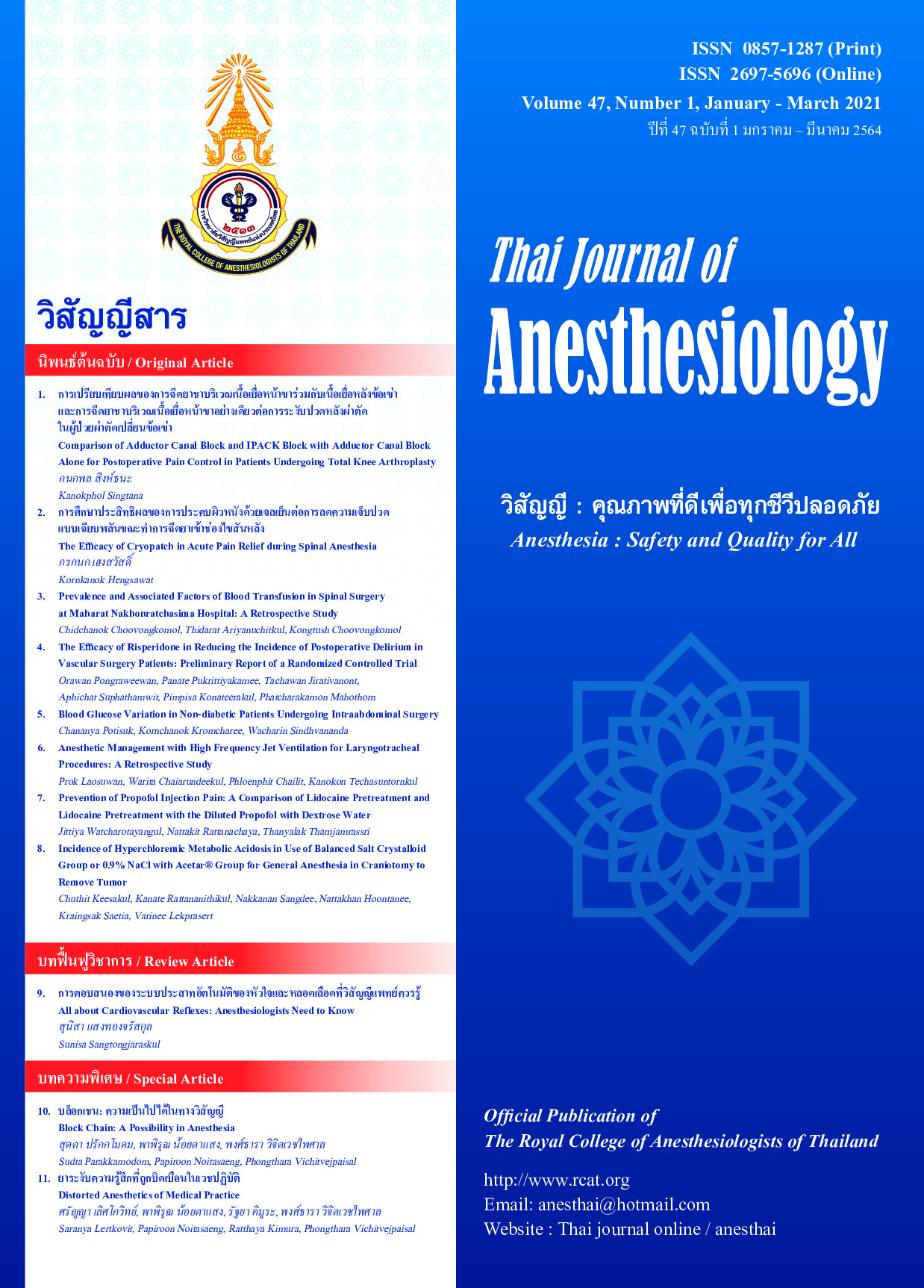Incidence of Hyperchloremic Metabolic Acidosis in Use of Balanced Salt Crystalloid Group or 0.9% NaCl with Acetar® Group for General Anesthesia in Craniotomy to Remove Tumor
Main Article Content
Abstract
Background: Intravenous fluids are used daily for general
anesthesia. Normal saline (0.9% NaCl) is an isotonic
solution. Excessive use of saline has been observed to
result in hyperchloremic acidosis. Newer balanced
solutions having fewer electrolytes composition different
than plasma may avoid this effect. This study compared
change in acid-base balance and serum electrolyte with
use of 0.9% NaCl combined with Acetar® in 1:1 ratio group
and Sterofundin group.
Methods: Twenty-eight adult patients with ASA 1-3 who
were scheduled for craniotomy to remove tumor under
general anesthesia were randomized into two groups.
A balanced salt crystalloid group received sterofundin for
intravenous fluids. A 0.9% NaCl plus Acetar® group
received 0.9% NaCl and Acetar® in 1:1 ratio. Demographic
data and anesthetic data were recorded. The amount of
IV fluid given was guided with the goal directed to keep
euvolemia by an anesthesiologist. Arterial blood gas, base excess, and serum electrolytes were recorded at the
beginning of surgery, postoperative 1 hour, and 1 day. Two
patients were excluded due to incomplete records.
Results: Serum base excess and pH in baseline and
postoperative in Sterofundin group had more alkalosis but
was still in the normal range. A change in serum sodium
and chloride did not yield a statistical difference in both
groups. The amount of blood loss, urine output, operation
time, PRC, and total crystalloid given were not statistically
different. No patient developed acidosis.
Conclusion: Using Sterofundin® for IV fluids was not
different in incidence of hyperchloremic metabolic acidosis,
sodium and chloride than 0.9% NaCl plus Acetar® in 1:1
ratio for craniotomy to remove tumor. Using 0.9% NaCl
plus Acetar® in 1:1 ratio was a good method to avoid
acidosis from excessive intravenous 0.9% NaCl.
Article Details
References
2013;369:1243-51.
2. Guidet B, Soni N, Della Rocca G, et al. A balanced view of
balanced solutions. Crit Care 2010;14:325.
3. Grocott MP, Mythen MG, Gan TJ. Perioperative fluid
management and clinical outcomes in adults. Anesth Analg
2005; 100:1093-106.
4. Handy JM, Soni N. Physiological effects of hyperchloraemia
and acidosis. Br J Anaesth 2008101:141-50.
5. McFarlane C, Lee A. A comparison of plasmalyte 148 and
0.9% saline for intra-operative fluid replacement. Anaesthesia
1994;49:779-81.
6. McCluskey SA, Karkouti K, Wijeysundera D, Minkovich L,
Tait G, Beattie WS. Hyperchloremia after noncardiac surgery
is independently associated with increased morbidity and
mortality: A propensity-matched cohort study. Anesth Analg
2013;117:412-21.
7. Carlesso E, Maiocchi G, Tallarini F, et al. The rule regulating
pH changes during crystalloid infusion. Intensive Care Med
2011;37:461-68.
8. Hafizah M, Liu CY, Ooi JS. Normal saline versus balanced-salt
solution as intravenous fluid therapy during neurosurgery:
effects on acid- base balance and electrolytes. J Neurosurg
Sci 2017;61:263-70.
9. Wilkes NJ, Woolf R, Mutch M, et al. The effects of balanced
versus saline-based hetastarch and crystalloid solutions on
acid-base and electrolyte status and gastric mucosal
perfusion in elderly surgical patients. Anesth Analg 2001;93:
811-6.
10. Krebbel H, Feldheiser A, Müller O, et al. Influence of
goal-directed therapy with balanced crystalloid-colloid or
unbalanced crystalloid solution on base excess. J Int Med
Res 2014;42:468-86.
11. Rein JL, Coca SG. “I don’t get no respect”: The role of
chloride in acute kidney injury. Am J Physiol Renal Physiol
2019;316:F587-F605.
12. Zhang Z, Xu X, Fan H, Li D, Deng H. Higher serum chloride
concentrations are associated with acute kidney injury in
unselected critically ill patients. BMC Nephrol 2013;14:1-6.
13. Yunos NM, Bellomo R, Hegarty C, Story D, Ho L, Bailey M.
Association between a chloride-liberal vs chloride-restrictive
intravenous fluid administration strategy and kidney injury in
critically ill adults. JAMA 2012;308:1566-72.
14. Young P, Bailey M, Beasley R, et al. Effect of a buffered
crystalloid solution vs saline on acute kidney injury among
patients in the intensive care unit: the split randomized
clinical trial. JAMA 2015;314:1701-10.


